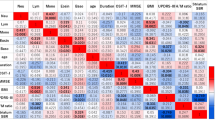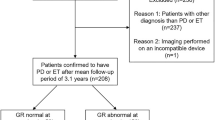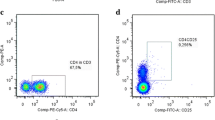Summary
In order to investigate the diagnostic value of3H-spiperone binding capacity to lymphocytes in the differential diagnosis of de novo Parkinson's disease (idiopathic Parkinson syndrome, PD), we performed a double blind prospective study of spiperone binding capacity of 123 patients and 23 healthy control persons, belonging to different diagnostic groups (PD, Parkinsonian syndrome due to vascular lesions, multiple system atrophy [MSA], essential tremor). Diagnoses were based on medical history, clinical examination, CT or MRI scan, acute response to dopamimetric drugs, one year follow up, and long term response to L-DOPA treatment. Spiperone binding was assayed using ten different concentrations (0.03–3 nmol) in absence or presence of 1μmol (+)-butaclamol to determine nonsepecific binding. There was no significant difference in spiperone binding between patients with PD not treated with L-DOPA, and patients with other basal ganglia disorders including parkinsonian syndrome due to vascular lesions, multiple system atrophy, or progressive supranuclear palsy, and age matched controls. Binding was significantly higher in parkinsonian patients with PD treated with L-DOPA and patients with essential tremor. It is concluded that at present3H-spiperone binding gives no further information in the differential diagnosis of de novo Parkinson's disease.
Similar content being viewed by others
References
Bondy B, Dengler FX, Oertel WH, Ackenheil M (1989)3H-spiperone binding to lymphocytes is increased in schiphrenic patients and decreased in parkinson patients. In: Przuntek H, Riederer P (eds) Early diagnosis and preventive therapy in Parkinson's disease. Springer, Wien New York, pp 205–212
Bondy B, Ackenheil M, Engel RR (1990a) Methology of3H-spiperone binding to lymphocytes. J Psychiatr Res 24: 83–92
Bondy B, Peuker B, Ackenheil M (1990b) [3H]Spiperone binding to lymphocytes in psychiatric disorders. In: Bunney WE jr, Hippius H, Laakmann G, Schmauss M (eds) Neuropsychopharmacology. Springer, Berlin Heidelber New York Tokyo, pp 148–150
Bondy B, Ackenheil M, Ruppert T (1992) Spiperone binding in lymphocytes: part of a dopamine uptake system? In: Fabris N, Jankovic BD, Spector NH (eds) Recent research in neuroimmunomodulation. New York Academy of Sciences, New York (in press)
Czlonkowska A, Jachowicz-Jeszka J, Czlonkowski A (1987) [3H]Spiperone binding to lymphocyte in extrapyramidal disease and aging. Brain Behav Immun 1: 197–203
Fleminger S, Jenner P, Marsden CD (1981) Are dopamine receptors present on human lymphocytes? J Pharma Pharmacol 34: 658–663
Gasser T, Schwarz J, Arnold G, Trenkwalder C, Oertel WH (1992) Apomorphine test for dopaminergic responsiveness in patients with previously untreated Parkinson syndrome. Arch Neurol (in press)
Gibb WRG, Lees AJ (1989) The significance of the Lewy body in the diagnosis of idiopathic Parkinson's diseae. Neuropathol Appl Neurobiol 15: 27–44
Hughes AJ, Lees AJ, Stern GM (1990) Use of apomorphine to test for dopaminergic responsiveness. Lancet 336: 8706–8710
Hughes AJ, Lees AJ, Stern GM (1991) Challenge test to predict the dopaminergic response in untreated Parkinson's disease. Neurology 41: 1723–1725
Jellinger K (1987) The pathology of parkinsonism. In: Marsden CD, Fahn S (eds) Movement disorders, vol 2. Butterworth, London, pp 124–165
LeFur G, Meiniger V, Gerard A, Baulac M, Uzan A (1980) Decrease in lymphocyte3H-spiroperidol binding sites in Parkinsonism. Life Sci 27: 1587–1591
Maloteaux JM, Waaterkein C, Laduron PM (1982) Absence of dopamine and muscarinic receptors on human lymphocytes. Arch Int Pharmacodyn 258: 174–176
Maloteaux JM, Gossuin A, Waterkein C, Laduron PM (1983a) Trapping of labelled ligands in intact cells: a pitfall in binding studies. Biochem Pharmacol 32(17): 2543–2548
Maloteaux JM, Laterre CE, Hens L, Laduron PM (1983b) Failure of peripheral dopaminergic marker in Parkinson's disease. J Neurol Neurosurg Psychiatry 46: 1146–1148.
Oertel WH, Gasser T, Trenkwalder C, Ippisch R, Poewe W (1989) Apomorphine test for dopaminergic responsiveness. Lancet i: 1262–1263
Ward CD, Gibb WR (1990) Research diagnostic criteria for Parkinson's disease. In: Streifler MB, Korczyn AD, Melamed E, Youdim MBH (eds) Parkinson's disease: anatomy, pathology, and therapy. Raven Press, New York (Adv Neurol 53: 245–249)
Wodarz N, Fritze J, Kornhuber J, Riderer P (1992)3H-Spiroperidol binding to human peripheral mononuclear cells: methodological aspects. Biol Psychiatry 31: 291–303
Author information
Authors and Affiliations
Rights and permissions
About this article
Cite this article
Arnold, G., Bondy, B., Bandmann, O. et al. 3H-spiperone binding to lymphocytes fails in the differential diagnosis of de novo Parkinson syndromes. J Neural Transm Gen Sect 5, 107–116 (1993). https://doi.org/10.1007/BF02251201
Received:
Accepted:
Issue Date:
DOI: https://doi.org/10.1007/BF02251201




